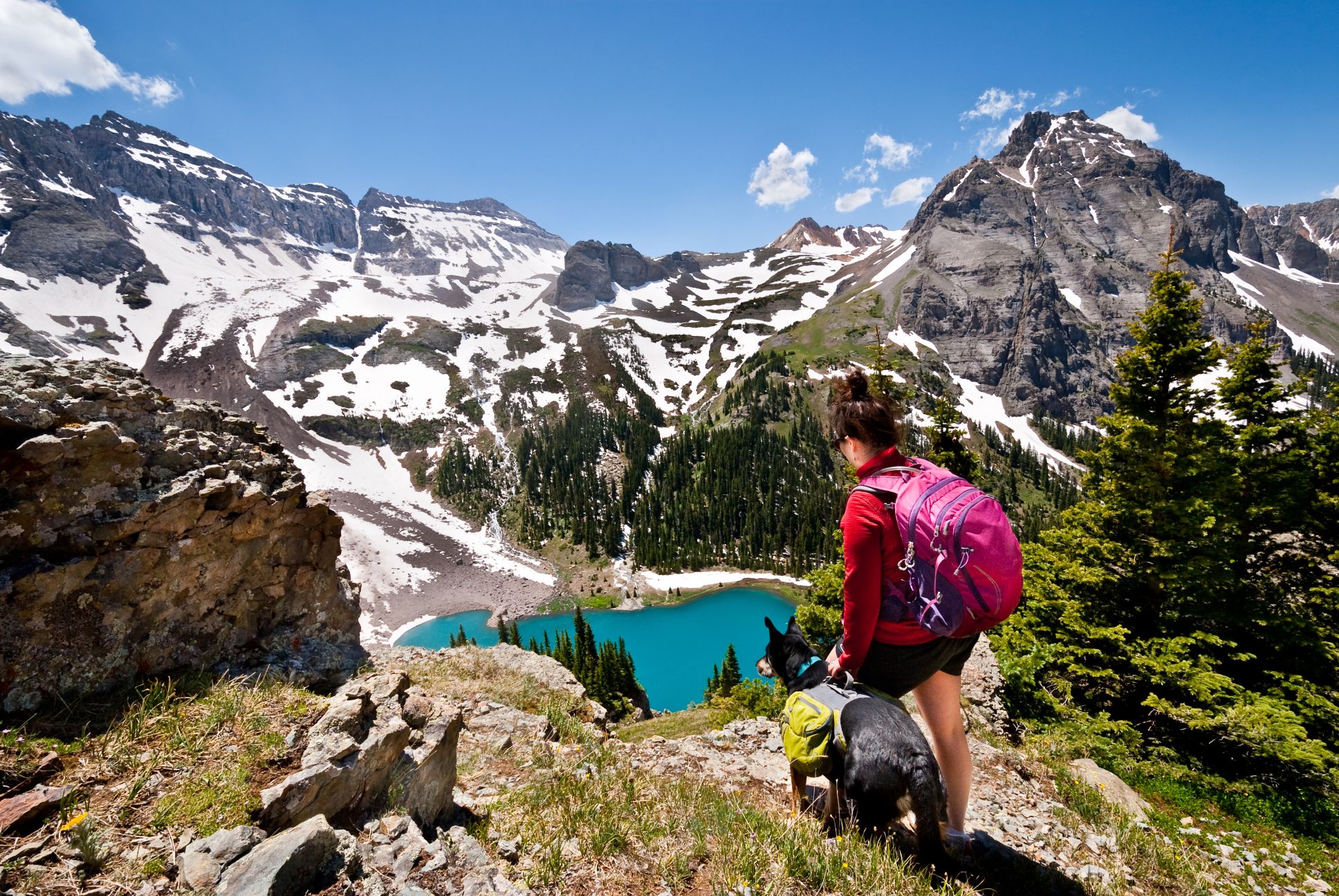Hiking the Trails Safely with Your Dog

Colorado is full of majestic mountains and scenic trails that are hard to resist, especially, when
sharing them with your canine hiking companion. At Lone Tree Veterinary Medical Center, we believe that hiking the trails safely with your dog involves proper training and preparation.
To ensure a great experience, you need to get your dog ready for different terrains, weather conditions—from heat and cold to rain and snow—and changing elevations. Keep reading for tips on staying safe and avoiding common mistakes that could get you into trouble.
Train Your Dog Ahead of Time
As with humans, hiking Colorado trails at both lower and higher elevations can cause problems for dogs, including, heat stroke, dehydration, exhaustion, and altitude sickness. You can minimize the chance of these occurring by first making sure your dog has had a recent physical check-up and is healthy enough to handle hiking in general, both at lower and higher elevations. You should also follow these training & hiking guidelines:
Basic Commands
Train your dog to walk by your side on a lead and to reliably respond to basic commands such as “heel,” “come,” “stay,” “leave it,” and “no.” If your dog needs help with these skills, consider enrolling in a class or consulting with our Pet Behavior Specialist.
Training
Take the time to train your dog to be out on a trail and to hike uphill. Work up to longer excursions over a period of a few weeks. This is well worth the effort, as your dog will be much better prepared for the physical demands of mountain hiking. Gradual training will also help prevent muscle soreness and overuse injuries.
Leash Control
Use a lead no longer than 6 feet and avoid retractable leads altogether. Be responsible and keep your dog on its lead, under control and close to you. You never know when you’ll come upon a rattlesnake, other wild animal, another human, or a loose/aggressive dog and you need that control. Avoid letting your dog wander off the trail for the same reason.
Trail Etiquette
Follow proper trail etiquette to ensure the safety of your dog and others you may encounter. Be prepared to yield to uphill hikers, runners, cyclists, and horseback riders.
Hiking Trails in Warmer Months
During the warmer months of the year, hike during the cooler parts of the day, especially, if you’re covering terrain that is in full sun. Dogs can easily overheat without the benefit of shade, especially, during the hottest times of the day. Overheating, dehydration, and other heat-related problems can affect any dog, regardless of its age, and cause serious problems.
Fatigue
Never force your dog to continue on a hike if it slows down or shows signs of fatigue. Stop and rest, and if your dog doesn’t regain energy, it’s time to turn back. Always monitor your dog’s energy level and behavior.
Elevations 8,000 Feet and Above
Avoid attempting a high-altitude hike with a dog that has not been properly acclimated to elevations above 8,000 feet and higher. Many mountain trails will take you well above timberline to 11,000 – 12,000 feet, and hiking a fourteener means going up to and over 14,000 feet. Only healthy dogs that are well-trained and acclimated for these altitudes and long distances should be taken on a hike to these elevations.
Rest Day
Always allow your dog rest days after hiking days, especially, if the hike was long, your dog is older, or is not as well acclimated to the level of activity. Just as humans, dogs need recovery time and it will vary depending on your dog’s age, health status and fitness level. Dogs are also susceptible to overuse problems with muscles and joints, and adequate rest/recovery time, along with gradual training, will help prevent them.
Packing the Right Gear for the Hike
Before you head out for the day, take stock of how long you plan to be on the trail, check the day’s weather forecast, and pack supplies for your dog accordingly. The following items are essential when hiking with a dog:
- How long do you plan to be on the trail?
- Check the day’s weather forecast
- Pack supplies for your dog accordingly
The items are essential when hiking with a dog:
- A 6 foot, non-retractable lead
- Properly fitted and comfortable harness or collar
- Clear identification for your dog
- Plenty of water ‒ more than you think your dog will need
- Food and treats for the day
- A collapsible dog bowl that is easy to carry
- Plastic bags for pet waste
- Properly fitted dog raincoat or jacket, booties
- Canine first-aid kit and emergency blanket
- Emergency dog carry-out harness, just in case
Pet First-Aid Kit
Even if you are just riding around in your car, it’s always a good idea to have along a complete pet first-aid kit. This is especially important when far from home or a veterinary hospital, which applies to most hiking trails in our state. Read here for more information on how to prepare a first aid kit for your pet that is easy to take along wherever you go.
Head Out Early
Start your hike early in the morning to ensure you have enough time to reach your destination and return before a storm hits or darkness falls. This is especially important if you plan to go above 10,000 feet, as sunny mornings can quickly turn into blustery storms by midday at high elevations. Additionally, lightning poses a constant risk above the timberline.
Starting early also lets you enjoy cooler temperatures as you pass through lower elevations, where temperatures can rise quickly by late morning.
Earlier starts also allow for cooler temperatures as you pass through the lower elevations where temperatures can rise quickly by late morning.
Avoid Altitude Sickness
Denver sits at 5,280 feet above sea level. Although most of us are used to this altitude in our daily activities, our pets may not be. Here are the signs of altitude-related sickness include:
- Shortness of breath
- Excessive panting, drooling
- Pale gums
- Lethargy
- Bleeding from the nose
- Vomiting
- Collapse
For more information and guidelines on altitude sickness, read our blog on how altitude affects pets and preventing altitude sickness. Nothing will ruin a hike faster than having to carry your dog out due to exhaustion, sickness or other altitude problem.
Watch for Rattlesnakes
If your dog is bitten by a rattlesnake, you have about an hour to get to a pet emergency facility for medical care, regardless of where the bite is on the body. Prompt treatment is crucial to prevent debilitating and life-threatening symptoms.
Rattlesnake venom is highly toxic and causes pain, swelling, internal bleeding, difficulty breathing, shock and death within a relatively short period of time. Treatment for rattlesnake bites typically requires the administration of Antivenin (sometimes several doses) along with intravenous fluids and 24-hour monitoring. Survival often depends on how quickly treatment is provided. These are all reasons why it is important to not let this happen to your dog while out on the trail.
Know Your Dog
For most dogs, hiking in the mountains is an enjoyable activity that is well-tolerated. However, some breeds are predisposed to having problems and require additional attention:
Elevations above 5,000 Feet
Monitor brachycephalic (short-nosed) breeds like Boxers, Pugs, Pekingese, Bulldogs, or any pet with breathing issues closely at elevations above 5,000 feet. These breeds already struggle with breathing problems, which higher altitudes can worsen.
Heart Conditions & Heart Murmurs
Dogs with a heart condition or heart murmur, regardless of breed, SHOULD NOT be taken on hikes above 8,000 feet. They are at a much higher risk for having a serious, life-threatening problem at higher elevations.
Overweight and Sedentary Dogs
Overweight and sedentary dogs will need to be trained gradually over a period of weeks. Starting out on flat terrain, do short walks out and back (30 minutes or less). Increase the distance and time as your dog adapts. Introduce uphill terrain in the same way.
Sensitivity to Hot and Cold Temperatures
Some dogs have more difficulty than others at tolerating the heat of summer or the cold of winter. While the reasons for this vary, pay attention to how your dog is doing and adjust your hike as needed. If your dog seems overly sensitive to heat or cold when outdoors, schedule a check-up with your veterinarian to rule out a medical problem. Your veterinarian may also recommend ways to keep your dog more comfortable.
We’re Here to Help
If you have questions about your pet’s health or would like to schedule an appointment for your pet, please do not hesitate to contact us. We are here to help!



